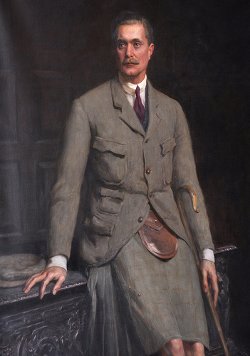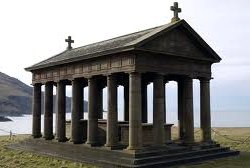Sir George Bullough, 1st Baronet – The Builder of the Kinloch Castle

Sir George Bullough, 1st Baronet and the builder of the Kinloch Castle was born in 1891 to John Bullough, a Leicester textile tycoon who bought the Isle of Rum in 1888. He spent his childhood in Accrington, Lancashire and London where he attended the Harrow School. His parents divorced when he was 12 years old and he stayed with his father. It remains unknown how much contact he had with his mother. When he was aged 21, he inherited half of his deceased father’s company (the other half went to his half-brother) as well as the Isle of Rum where he decided to build a mausoleum for his father. The mausoleum still stands but the present-day Doric style mausoleum is a later construction as George decided to demolish the original one and build the current one instead.
After his father’s death, he travelled extensively with his steam-yacht Rhouma. He visited most of the world and collected many artefacts and furniture, many of which he later brought to the Kinloch Castle. He decided to build the castle in the late 19th century and hired the London-based Leeming & Leeming architectural firm for the project. Construction of the Kinloch Castle began in 1897 and was completed in 1901. But rather than moving into the newly built luxurious retreat, he decided to lend it to the British army to use it as accommodation for the wounded soldiers from the Second Boer War. At the same time, he lent his yacht Rhouma as a hospital ship to the British navy in order to bring the wounded soldiers from South Africa to Britain. For this contribution during the Boer War, King Edward VII knighted him in 1901. He was awarded the title of Baronet in 1916 for his service during the First World War.

In 1903, Sir George Bullough married Monique Lily de la Pasture, the daughter of the Fourth Marquis de la Pasture whose family left France during the French Revolution. It is unknown when he met Monique who is also known as Lady Monica but they had a romantic relationship while she was officially still married as his name was used in the divorce papers. Sir and Lady Bullough had only one daughter, Hermione. She was married to John Lambton, 5th Earl of Durham who is remembered for giving the Penshaw Monument (built in 1844) on Penshaw Hill to the National Trust as a gift.
In addition to building the Kinloch Castle, Sir George Bullough is also remembered for his interest in horses and Thoroughbreds racing. In 1917, won the 1917 Grand National with his horse Ballymacad, while Golden Myth won him the 1922 Ascot Gold Cup and Eclipse Stakes. In 1934, he also won the English classic with Campanula.
Sir George Bullough died in 1939 and was buried in the mausoleum on the Isle of Rum next to his father. His widow, Lady Bullough sold the castle and the island to the Nature Conservancy in 1957 but she retained the ownership of the mausoleum where she was buried as well after her death in 1967.